Following our conversation during the 59th New York Film Festival on the history of directing and filming Lou Reed and John Cale’s Andy Warhol tribute Songs For Drella (a highlight in the Revivals programme) Ed Lachman spoke with me about his role as cinematographer on Todd Haynes’ (Main Slate selection) The Velvet Underground. The documentary captures the transformation and growth of Lou Reed, John Cale, Maureen Tucker, and Sterling Morrison, after the band was introduced by Barbara Rubin to Andy Warhol, who added Nico into the mix.
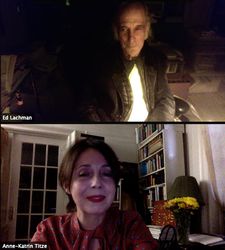 |
| Ed Lachman with Anne-Katrin Titze on Vittorio De Sica’s Umberto D.: “That was really the film that incited in me the idea that you could tell stories with images.” |
Haynes in all his films, and often aided by longtime collaborator Lachman (Dark Waters, Wonderstruck, Carol, I'm Not There, Far From Heaven), never gives an inch of aesthetic pleasure for substance, as we realize they can be the same. Ed shot the interviews with Lou’s sister Merrill Reed Weiner, Jonathan Richman, Amy Taubin, Jackson Browne, Mary Woronov, Gerard Malanga, La Monte Young, Doug Yule, Danny Fields, Sterling’s wife Martha Morrison, Tucker and Cale, and as I learned not the John Waters one.
An overfull experience of what was and is The Velvet Underground and its periphery is the result. In this case especially, add the music to it and the split screen unfolds like a precocious flower, sometimes cut into the little boxes we all have become so cosily familiar with in these pandemic times. “Music fathoms the sky…” - the quote by Baudelaire functions as epigraph and Andy Warhol’s Screen Tests, where the subject looks straight at us, lasso us in while moving footage from the Sixties flickers and winks and visually comments on what we are hearing, as if we were partly dreaming. A mood and Lou Reed’s voice likening going to the movies to a drug.
From New York City, the day after the New York Film Festival closed, Ed Lachman joined me for an in-depth conversation on The Velvet Underground.
Anne-Katrin Titze: Hi Ed!
Ed Lachman: Hi Anne-Katrin! What happened to that other interview we did?
AKT: It’s already posted.
EL: Oh, I didn’t see it. Will you send it to me?
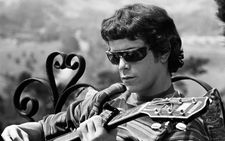 |
| Ed Lachman: “Todd does look books which informs all the departments about what he’s looking for to create style.” |
AKT: Of course I will. This is the bracket of the New York Film Festival. How was your festival?
EL: It went wunderbar. I had three films. Songs for Drella they showed in an extra screening. Usually you send me an e-mail, so I didn’t see it.
AKT: I will send it to you. You did a talk on Mississippi Masala, how did that go?
EL: It was great.
AKT: What we didn’t talk about earlier were some of the interviews for Velvet Underground, John Waters for example.
EL: You know what? Strangely enough, I didn’t shoot that one. What happened was, he was in Baltimore, whatever, and they sent a local crew to shoot that and they sent him the questions. And I worked long and hard to make that look like what we did, because that crew was not very good.
AKT: Not up to your standard?
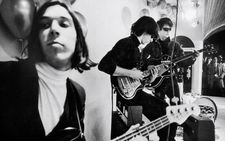 |
| Ed Lachman on Christine Vachon: “She’s close and Todd’s producer, so I’ve had the fortune to work with her on all those projects.” |
EL: Well, they didn’t have the same aesthetic. The aesthetic that we wanted in all those interviews was really twofold. One was Andy Warhol’s Screen Tests where he sat there with his Bolex, with one light source, and two, because it was in color, we reference Warhol’s silk screens, the lithos where he used different color palettes to create these pencil drawing kind of faces. You know, Marilyn Monroe and Debbie Harry. So we used that kind of colored backgrounds that we brought with us on a canvas that had the texture and then I lit it with gels to make it feel like it was some place between a silk screen and Warhol’s Screen Tests.
AKT: It’s really really beautiful. Jonathan Richman …
EL: That I did though!
AKT: Tell me about the interview with him! He’s so enthusiastic, it’s contagious.
EL: He was so inspiring. You know, the funny part, like any film with Todd it’s like an education. I never would have dreamed that Jackson Browne had anything to do with The Velvet Underground but he used to play in Nico’s band and was around that whole scene. And then the same thing with Jonathan Richman, I knew of him, but I didn’t know his connection to The Velvet Underground. He was, as you say, so animated and inspiring.
 |
| Andy Warhol's Index Book, collection Ed Bahlman Photo: Anne-Katrin Titze |
AKT: So it’s always an education for you with every film you make?
EL: Every film, and especially with Todd Haynes.
AKT: Douglas Sirk always comes to my mind …
EL: Of course, Far From Heaven. Different language for different film.
AKT: I know, but somehow I always think of Douglas Sirk when I think of your work with Todd Haynes.
EL: Maybe because Sirk understood from a Brechtian world, which you know, understood how you create images out of ideas. And Todd is always creating images out of ideas, not out of pure aesthetics. The ideas create the aesthetic. Maybe that’s the reference. Our images aren’t always as mannered and artificial like Sirk, but we’re saying something about the artificiality of people’s lives in the Fifties. That they weren’t living up to the standards that they wanted to live up to, like Life magazine.
That isn’t necessarily the same feeling as, let’s say Carol, which is also Fifties. Carol was just after the war, with a much more, how can I say, much more soiled, lived-in world. It wasn’t the optimism of materialism like Douglas Sirk was referencing in the mid- to late Fifties. They were just coming out of the effort of the war, so we referenced more the farm security photographers that were documenting the rural and the cities.
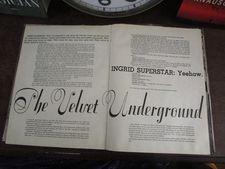 |
| Ingrid Superstar on The Velvet Underground in Andy Warhol's Index Book, collection Ed Bahlman Photo: Anne-Katrin Titze |
AKT: You mentioned the ideas, and yes, I went to Bertolt Brecht high school, so I know.
EL: Genau!
AKT: The idea goes together with the aesthetic.
EL: The idea is the aesthetic. Todd does look books which informs all the departments about what he’s looking for to create style. It could be the history, the music, the social issues, the demographics, the film language of the time - all these things inform why the images were created the way they were. What they were in opposition to. That’s what gives the specific detail, the understanding of what the images represent.
AKT: Are you working on the Peggy Lee film at the moment?
EL: Yes. We’re still in research. There’s a wealth of visual information around her.
AKT: Christine Vachon was producing The Velvet Underground and you’ve been collaborating with her for a long time.
EL: Yes, she’s close and Todd’s producer, so I’ve had the fortune to work with her on all those projects.
AKT: As a cinematographer, what was the moment when you realized, as a child, watching a movie, that there is such a thing as a cinematographer?
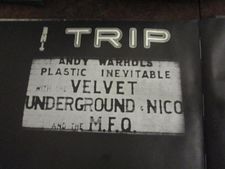 |
| Plastic Inevitable with The Velvet Underground & Nico in Andy Warhol's Index Book, collection Ed Bahlman Photo: Anne-Katrin Titze |
EL: My father owned a movie theater and my grandfather owned many. But I didn’t know him.
AKT: Where was that?
EL: In New Jersey. But when I was at Harvard, I took an appreciation survey course from Gideon Bachman. He was very close to Fellini and and expert on the Italian neorealists. And the film was Umberto D. by De Sica. Because that film was totally constructed with images, there was very little dialogue, hardly any dialogue. It was a black and white early De Sica film, he’s making a social commentary on Italy at that time. And I was so taken that you could use found images, or what I considered found images, images in a reality, and tell a story. That was really the film that incited in me the idea that you could tell stories with images.
AKT: Did you travel a lot to shoot the interviews?
EL: Yeah, we went to San Francisco for Jonathan Richman. We went to L.A. for Jackson Browne. We went to Atlanta and the Georgia countryside for Moe Tucker. We travelled around depending on people’s schedules and availability.
AKT: Do you like these kinds of assignments?
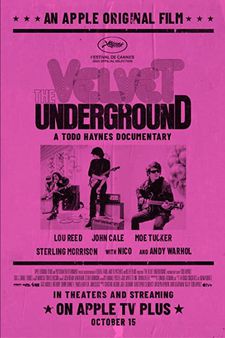 |
| The Velvet Underground poster |
EL: Sure, I started out in documentary and I hope I never leave it. I used to work with Al Maysles, the Maysles Brothers. And Al would always say, why make a narrative feature when you can always find it in reality? That was Al’s take on things, in fact, when I did Desperately Seeking Susan, which was my big break, I could never tell Al that I wasn’t shooting a documentary. So I told him I was doing a documentary about this girl named Madonna. I never told him it was a narrative film.
Coming up - Ed Lachman on working with Rainer Werner Fassbinder, Wim Wenders, Volker Schlöndorff, and going to Schumann's American Bar.
Read what Ed Lachman had to say on the history of Songs For Drella with Lou Reed and John Cale.
The Velvet Underground opens at Film Forum in New York on October 13. Post-screening Q&As with editors Affonso Gonçalves and Adam Kurnitz on Thursday, October 14, 7:50pm and on Saturday, October 16, 7:50pm. Amy Taubin will introduced the Friday, October 15, 7:30pm screening. The Velvet Underground streams on Apple TV+ starting on October 15.
The Velvet Underground also opens at Film at Lincoln Center's Walter Reade Theater on October 13.






















